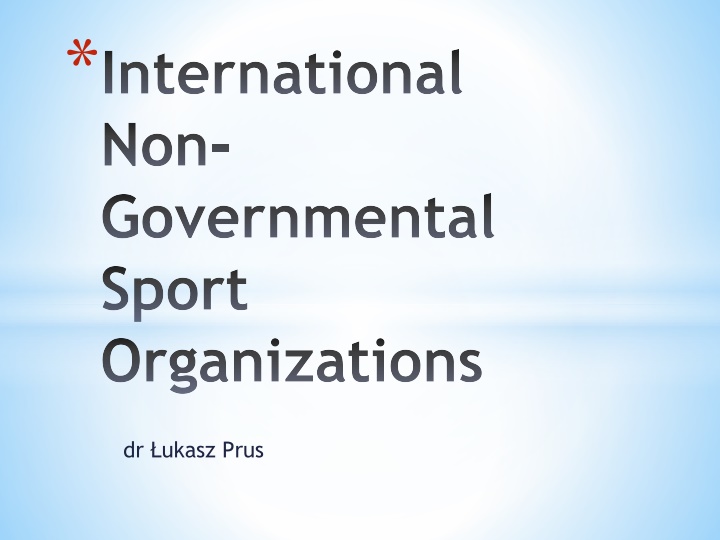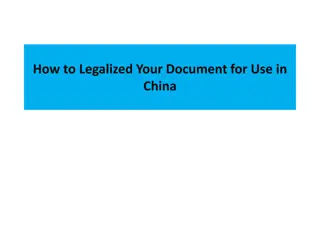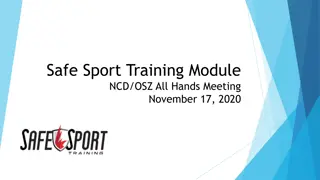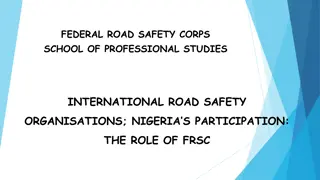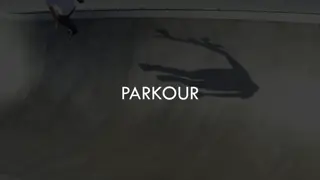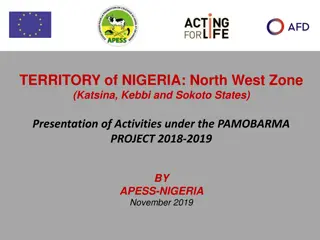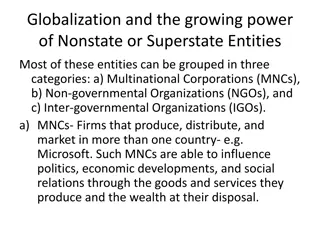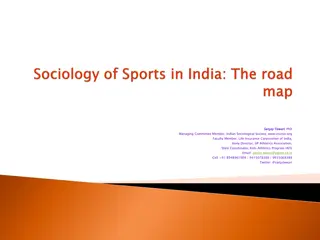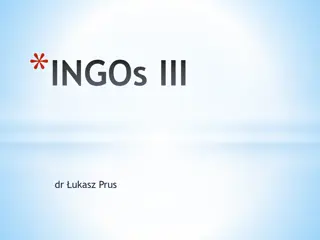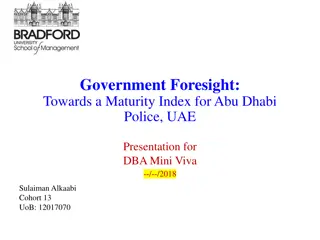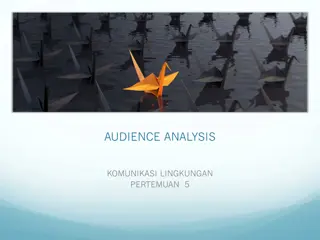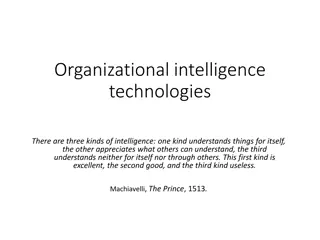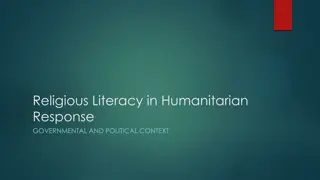International Non-Governmental Sport Organizations: Organizational Phenomenon and Governance
In the realm of sports governance, International Non-Governmental Sport Organizations (INGSOs) play a crucial role as supreme bodies governing sports globally. They operate with autonomy and self-governance, standing at the top of a power chain. This article delves into the relationship between organizational theory and sports, exploring the accountability of transnational governing bodies like FIFA and the impact of public authorities on INGSOs.
Download Presentation

Please find below an Image/Link to download the presentation.
The content on the website is provided AS IS for your information and personal use only. It may not be sold, licensed, or shared on other websites without obtaining consent from the author.If you encounter any issues during the download, it is possible that the publisher has removed the file from their server.
You are allowed to download the files provided on this website for personal or commercial use, subject to the condition that they are used lawfully. All files are the property of their respective owners.
The content on the website is provided AS IS for your information and personal use only. It may not be sold, licensed, or shared on other websites without obtaining consent from the author.
E N D
Presentation Transcript
*International Non- Governmental Sport Organizations dr ukasz Prus
*On the one hand, * in era of growing politization and governance of sport is interesting to note that *transnational governing bodies/organizations of sport e.g. FIFA are not accountable to any government. *On the other hand, relation between theory of organization and sport is a great picture, which illustrates organizational phenomenon. 2
*Various terms: *Global Sports Organisations (GSO) *Sport Governing Bodies (SGB) *International Federations (IF) *International Sport Organisations (ISO) *International Non Governmental Sport Organisations (INGSOs) 3
*GSO are INGOs that govern sport and sport events. *INGSOs are the legitimate bodies to promote and develop their sport. *INGSOs can be defined as private authorities , *in the sense that they are private institutions *that exercise what is perceived as legitimate authority at a global level in sport sector. 4
*INGSOs is the main regulatory bodies of the sports world *but at the European level, the Bosman ruling forced EU involvement in sport sector. *Governing networks in sport are based on a model created *in the last few decades of the 19th century by the Football Association (FA), *the governing body of the game in England to this day. 5
*This implies that INGOs are the supreme governing bodies (authorities) of sport *since they stand on the top of a vertical chain of commands (chain of power), *running from continental, *to national, *to local organisations. 6
*INGSOs have traditionally known *a large autonomy and in that sense, *they were subject to almost complete self-governance. *Public authorities at national level have had very little impact on their functioning. 7
*The sporting network was even able to exercise its self governance without any significant interference from states or other actors and, *cherishing its political autonomy, *the sports world generally avoid state intervention in its activities. 8
*Our government had to give up twice time in conflict with FIFA (2006 and 2008). *The FIFA threatened that if the government wanted to reform the national federation, *it would exclude us from international games. 9
*Headquarters? *This is mostly Switzerland, *where they are settled into a legal system *that gives them enormous protection against internal and external examination. 10
*Political autonomy *Legal autonomy *Financial autonomy *Supervised autonomy 11
*Political autonomy *Separation of sport and public authority. *The International Olympic Committee (IOC), was founded in 1894 by Pierre de Coubertin. *Since its creation, the IOC has been the supreme authority on all questions regarding the Olympic Movement, *a complex system created to regulate the Olympic Games. 12
*de Coubertin strongly believed that politicians could only violate sports integrity stating that: * the beam formed by the goodwill of all members of an autonomous sport, *relaxes when the giant figure of this dangerous and imprecise figure called State appears *(de Coubertin, 1909) 13
*Thhe word autonomy appears for the first time in the Olympic Charter only in 1949: *in order to be recognised by the IOC, the National Olympic Committees (NOCs) must be free from any interference from national authorities 14
*Both FIFA and the IOC have been very influential on the creation of other INGSOs and hence, * the sports world generally prevent (eschews) state intervention in its activities. 15
*Legal autonomy *Autonomy to adopt rules and norms that *have a legal impact in a legal framework imposed by the State, *be it at national or at international level. 16
*Most of INGSOs are located in Switzerland *As non profit associations. *Except the World Anti Doping Agency which is incorporated as a foundation. 17
*Non-profit associations fall under the provision of the Swiss Civil Code (articles 60) which provides minimum requirements for an association to be created, such as *writing and adopting statutes, *having an ideal objective and *resources. 18
*The Council of Europe already recognised this conceptualisation of autonomy *in the early 1990s through the European Sports Charter (1992). *The Charter stipulates that voluntary sports organisations have the right *to establish autonomous decision-making processes within the law (Council of Europe, 1992). 19
*Legal autonomy of INGSO in EU. *In some cases, the legal autonomy of sport has been challenged *by the decisions of the Court of Justice of the EU (CJEU). 20
*Case study *CJEU *Free movement of workers within the EU not only applies to the action of public authorities *but extends also to rules of any other nature aimed at regulating gainful employment in a collective manner. 21
*Free movement of workers within the EU applies to rules laid down by sporting associations such as URBSFA, FIFA or UEFA, which determine the terms on which professional sportsmen can engage in gainful employment *It is clear that Mr Bosman had entered into a contract of employment with a club in another Member State with a view to exercising gainful employment in that State. 22
*Since the situation in issue in the main proceedings cannot be classified as purely internal. *About existence or not of an obstacle to freedom of movement for workers. 23
*Provisions which preclude or deter *a national/citizen of a Member State from leaving his country of origin *in order to exercise his right to freedom of movement therefore *constitute an obstacle/barrieres to that freedom even if they apply without regard to the nationality of the workers concerned. 24
*Crossborder transfer rules adopted by Union of European Football Associations (UEFA) and Belgian Football Federation *provide that a professional footballer may not pursue his activity with *a new club established in another Member State *unless it has paid his former club a transfer fee agreed upon between the two clubs or determined in *accordance with the regulations of the sporting associations, constitute an barrieres to freedom of movement for workers. 25
*Decisions violated EUs internal market principles. *Some decisions of these organizations violates internal EU market principles, *specially the freedom of movement of workers in the EU. *The CJEU has dealt with the freedom of movement and sport in numerous cases, most notably in the Bosman case . 26
*TOP 10 Bosmans: *Steve McManaman - Liverpool to Real Madrid, 1999 *Edwin van der Sar - Ajax to Juventus 1999 *Sol Campbell - Spurs to Arsenal, 2001 *Cafu - Roma to AC Milan 2003 *Michael Ballack - Bayern Munich to Chelsea, 2006 *Andrea Pirlo - AC Milan to Juventus, 2011 *Robert Lewandowski - Borussia Dortmund to Bayern Munich, 2014 *Zlatan PSG to Mentchester United, 2016 27
*Financial autonomy *In the past, sport relied heavily on public financial suport. *However, with the commercialization of sport came the growing independence of sports organisations. 28
*A key factor in that regard has been the breakthrough of sports broadcasting (rights to tv transmission). *Example *The 2010 FIFA World Cup made EUR 1,802 million through the sale of television rights, and EUR 802 million via marketing rights. Overall, South Africa 2010 accounted for 87 per cent of FIFA s total revenue during the 2007 2010 period 29
*Functional autonomy *Autonomy can also be explained in a functionalist perspective. *Sports organisations adopt technical sports provisions, * the sport provisions sensu stricto, *which regulates rule of game. 30
FIFA govern rules (provisions) for football on global basis. The most obvious example of such a rule is perhaps the offside rule in football. 31
*The functional autonomy of sports organisations has been strengthened in recent years *by the development of a system of sports arbitration *which has contributed to the emergence of a body of global sports law/lex sportiva. 32
*The sports world has devised its own legal system *which enables it to settle disputes within *its own network and according to its own laws instead of in national or European courts. 33
*The importance of sports arbitration has increased significantly after the establishment of the Court of Arbitration for Sport (CAS), * an arbitral institution created by the IOC in 1983 which is competent to resolve all types of disputes of a private nature relating to sport. 34
*Another illustration of the tension between lex sportiva and ordinary state law is the potential issue of double sanctions *a sports sanction and a public sanction. 35
*Offender may be sanctioned by two different legal systems according to the context. *Suspicious behaviour on the field or, as it was the case for the two Badminton players at the London Olympic Games, * not using one's best efforts to win a match *can be interpreted as a lack of fair play, *but it can also potentially be sanctioned by a breach of sports rules (i.e, the disqualification of two players for throwing matches ). *Accordingly, manipulation of the outcome of a game may also be brought before ordinary courts 36
*Supervised autonomy *Limited legal competences regarding sports and *because of the recognised autonomous status of sports governing bodies at the European level , *the EU does not have the power to intervene strongly in the sector. 37
*However after the Bosman ruling, the sports world realised that EU law could have far * reaching consequences for their activities and embarked on a campaign directed towards the EU. 38
*Networks *Administration (management) takes place in a network run by * regional or global organizations, * which are an umbrella for national federations. 39
*The national associations are members of the F d ration Internationale de Football Association ("FIFA"), *an association governed by Swiss law, *which organizes football at world level. *FIFA is divided into confederations for each continent, whose regulations require its approval. 40
*Under FIFA are five continental organisations: * AFC (Asian Football Confederation), CAF (Confe de ration Africaine de Football), CONCACAF (Confederation of North, Central American and Caribbean Association Football), CONMEBOL (Confederacio n Sudamericana de Fu tbol), OFC (Oceania Football Confederation) and UEFA (Union of European Football Associations of Union Europe enne de Football Association 41
*The confederation for Europe is UEFA, also an association governed by Swiss law. * Its members are the national associations of some 50 countries, including in particular those of the Member States which, under the UEFA. *Each football match organized under the auspices of a national association must be played between two clubs which are members of that association or of secondary or subsidiary associations affiliated to it. 42
*The team fielded by each club consists of players who are registered by the national association to play for that club. *Every professional player must be registered as such with his national association and is entered as the present or former employee of a specific club. 43
*All the organisations in the network are in their own geographical/ functional sphere of competence responsible for the regulation of football but they have to report *to the organisations that stand above them in the network. *Hierarchic structure of those networks. *Such networks are called pyramid networks *because their hierarchic organisational structure visually resembles the shape of a pyramid. 44
*However, when we regard INGSOs as the main regulatory bodies of the sports world, their erosion or rather delegation of power mirrors the recent evolutions in societal governance quite perfectly. *With regard to stakeholders, in recent years, we witnessed an increasing influence of athletes in the development of policies in INSGOs. *NBA lockout *The role of players and clubs to grow 45
*Deos INGSOs financially, politically, legally, functionally autonomous enough to implement good governance? *Professional sports lack transparency *Ethical scandals in the sports world shows that it is no longer possible for sport organisations to be run as a closed book . *Consequently, transparency is regarded as one of the top level topics concerning good governance in INGSOs *https://www.youtube.com/watch?v=p_CKYdhAuUk 46
*https://www.youtube.com/wat ch?v=tkop8bgMs9M *Accountability *Why? *A lack of accountability arrangements constitutes a breeding ground for *Corruption *Concentration of power *Lack of democracy and effectiveness 47
*Usually explained in 3 ways: *A democratic means to monitor and control government conduct *(2) To prevent the concentration of power (checks and balances) *(3) It induces the executive branch to learn *executive body of SGB should be accountable to the Member federations! *Member federations have an important watchdog function 48
*Classifying International sport governing bodies: *1) Single sport (solo and team) *a) global FIFA *B) national/regional UEFA *2)Multisport *A) global International Olympic Committee *B) national/regional national Olympic Commitiees 50
